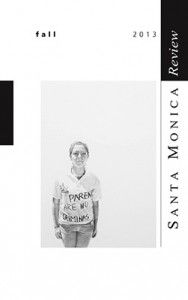 The latest issue of the Santa Monica Review (Fall 2013) showcases a number of short shorts. This isn’t the standard modus operandi—last issue, Spring 2013, contained only a few longer stories and a novella. This is something I appreciate about SMR—they feature a wide variety of tastes, styles and lengths, never narrowing the field of contemporary fiction down to a tiny sphere. In the current issue, SMR has collated the experimental and the surreal with the realistic and the minimalist. The danger, of course, of having such a wide range is that the journal becomes a hodgepodge. That is not the case here. Themes repeat throughout the journal, tying the parts into a whole. Some themes I’ve noticed over the last five or six issues: there are often stories about teachers or professors, there are many coming-of-age stories, with protagonists of high school age or in their early twenties, and there are often Catholics.
The latest issue of the Santa Monica Review (Fall 2013) showcases a number of short shorts. This isn’t the standard modus operandi—last issue, Spring 2013, contained only a few longer stories and a novella. This is something I appreciate about SMR—they feature a wide variety of tastes, styles and lengths, never narrowing the field of contemporary fiction down to a tiny sphere. In the current issue, SMR has collated the experimental and the surreal with the realistic and the minimalist. The danger, of course, of having such a wide range is that the journal becomes a hodgepodge. That is not the case here. Themes repeat throughout the journal, tying the parts into a whole. Some themes I’ve noticed over the last five or six issues: there are often stories about teachers or professors, there are many coming-of-age stories, with protagonists of high school age or in their early twenties, and there are often Catholics.
At the experimental end of the spectrum comes Rich Ives. His story, “Alternative Systems of Understanding Offering Heartwarming Potential” is as complex as the title suggests. It is fragmented into numbered chunks, with a repeated motif of sleeping with silverware (knife, fork and spoon are all bedmates), and piles up hallucinatory images in a madcap storm. One Socratic-minded section features only questions like “What is the purpose of a fairy tale?” and Why does God cry for his children?” The language pummels you, upending every expectation: “We’ve learned to value the lid of the bed, awakened, and its finger moons chambered with tensile eye-knuckles and naked feet running from the ceiling, night’s eye so big we don’t realize we’re inside.”
Also notable is Ryan Ridge and Mel Bosworth’s piece “A Dirty Dozen,” which feels like reading a prose version of Salvador Dali. It includes a baby forced to play drums seconds after its birth, a man who takes himself hostage, and a father who builds an engine that runs on seaweed. Sample passage: “Then birds flying upside down like jokes. Luchadors fighting at the fish taco truck. Women in sexy pioneer costumes crossing their fingers. Men in Black Sabbath tees. A man yelling: ‘Aspirin, Disneyland!’ Another man dousing himself in kerosene as his wife bursts into laughter from the flames.”
David Kranes story “The Burning Lake,” which launches the issue, is one of my favorites. It features a high school teacher fighting his administration about a student’s grade while managing a teetering relationship with a lover. Then the local lake catches on fire, inexplicably. The final scene is unpredictable and surreal and spot-on. It’s a fast story, with collisions from all angles, and it’s the type of story that gives you that giddy, flummoxed feeling attendant to all great fiction, reminding you of why you do this thing called reading.
Geoff Wyss’s story “Journal,” is also excellent, in which sex-seeking high school boys in New Orleans sneak into a convention for daughters of soldiers in Afghanistan. One of the girls, dressed up as a Goth, admits her reason for dressing that way, and her reasoning is surprisingly mature: she will do so until “the city is restored.” In a city ravaged by Katrina, this kind of idealism is a wonderful counterpoint to the horndog sex-trolling of the boys. The title doesn’t make sense until the last paragraph, when a journal plunging into a crowded auditorium serves as a scary metaphor for the impending disaster still looming over the city: “Not yet. Not yet. Not yet. Now.”
Although Santa Monica Review focuses on fiction, most issues roll out a few nonfiction pieces. The Fall issue has four. Christopher Buckley, a frequent contributor, offers an essay on his problems with math, Alex R. Jones serves up a memory from his childhood on the ritualized process of movie-going with his estranged father, and Marilyn Abildskov remembers the light and sounds and smells from the many countries she’s visited. Tom Lutz’s reporting on Iran is especially piquant. He travels to Tehran in 2010, ostensibly for a multiculturalism conference, but departs from the prescribed activities and gumshoes about the country talking to taxi drivers, families, subway riders, and anyone else who would speak with an American. His story of talking to Kurds in person (and failing to get anyone at the supposedly multicultural conference to speak about them) speaks volumes about the official guises of the country. What I liked best is that Lutz captures the exact feeling of travel—the language difficulties, the struggle with navigation, the random yet fortuitous encounters, and the experience of being in a land so foreign it makes you yourself and not yourself.
There are many more excellent stories that I don’t have time to describe in full—Michelle Latiolais’ “Promotion,” J.P. Gritton’s “Curly,” g c cunningham’s “My First Marine Corps Essay” (a fictionalized essay)—but in lieu of an exhaustive review, I would recommend buying the issue and reading it for yourself.
